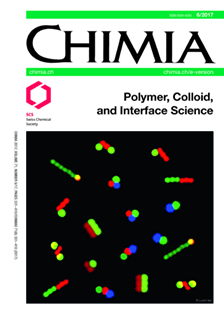Hybrid Colloids Produced by Sequential Capillarity-assisted Particle Assembly: A New Path for Complex Microparticles
DOI:
https://doi.org/10.2533/chimia.2017.349Keywords:
Active colloids, Colloidal molecules, Directed assembly, Hybrid colloidsAbstract
Colloidal particles have long been under the spotlight of a very diverse research community, given their ubiquitous presence in a broad class of materials and processes, and their pivotal role as model systems. More recently, intense efforts have been devoted to the development of micro- and nanoparticles combining multiple materials in objects with a controlled architecture, hence introducing multiple functionalities and a prescribed symmetry for interactions. These particles are often called hybrid colloids or colloidal molecules, given the analogy with classical molecules presenting well defined structures and chemical compositions. Here, we review the recent progress made in our group to fabricate a broad library of hybrid colloids exploiting a novel assembly route, which uses capillary forces at the moving edge of an evaporating droplet for the sequential composition of colloidal clusters, whose geometry and chemistry can be independently programmed.Downloads
Published
2017-06-28
Issue
Section
Scientific Articles
License
Copyright (c) 2017 Swiss Chemical Society

This work is licensed under a Creative Commons Attribution-NonCommercial 4.0 International License.
How to Cite
[1]
S. Ni, I. Buttinoni, H. Wolf, L. Isa, Chimia 2017, 71, 349, DOI: 10.2533/chimia.2017.349.







